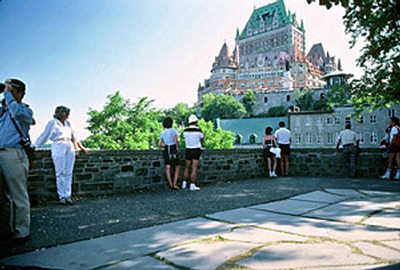Montmorency Park National Historic Site of Canada
Québec, Quebec

General view
© Parks Canada | Parcs Canada, P. St. Jacques, 1984.
Address :
Port-Dauphin and Côte de la Montagne Streets, Québec, Quebec
Recognition Statute:
Historic Sites and Monuments Act (R.S.C., 1985, c. H-4)
Designation Date:
1966-10-26
Dates:
-
1841 to 1866
(Significant)
-
1950 to 1950
(Significant)
Event, Person, Organization:
-
Monsignor de Saint-Vallier
(Person)
-
Claude Baillif
(Architect)
Other Name(s):
-
Montmorency Park
(Designation Name)
Research Report Number:
2020-13
DFRP Number:
05802 00
Plaque(s)
Existing plaque:
For nearly a century, the legislative councillors and members of the Parliament of Lower Canada (1792–1838), the Province of Canada (1852–1854; 1860–1865) and the Province of Quebec (1867–1883) met here. This place is associated with milestones in Canada’s political and constitutional history, notably the deliberations of the Québec Conference of 1864, where delegates from the British North American colonies drafted 72 resolutions that formed the basis of Confederation in 1867. After the fire that destroyed the Parliament Building in 1883, this site ceased to be a centre of political power and became a public park ten years later.
Description of Historic Place
Park Montmorency National Historic Site of Canada is located in the historic core of the City of Québec, at the top of Côte de la Montagne. It is an urban park that forms part of the Fortifications of Québec National Historic Site of Canada. No surface structure remains to illustrate its role as the site of the Legislative Assembly of Lower Canada, of the Parliament of the Province of Canada and of the Legislative Assembly of the Province of Quebec. Large cannons lining the wall speak to the site’s historical military role as a defensive battery. Bounded by a defensive wall, the site comprises mature trees, manicured grass, walkways, commemorative monuments and park benches all overlooking Place Royale and beyond to the St. Lawrence River. The official designation refers to the extent of the park at the time of designation.
Heritage Value
Montmorency Park was designated a National Historic Site of Canada in 1966. It is recognized because:
for more than a century, the site was the location of a number of buildings of parliament, starting with that of the Legislative Assembly of Lower Canada, from 1792 to 1838; it is one of the sites where the Parliament of the Province of Canada met between 1841 and 1866 and the place where the Quebec Conference of 1864 was held during which were drafted the 72 resolutions, upon with the British North America Act is based; the Legislative Assembly of the Province of Quebec sat at that location between 1867 and 1883.
In 1688, Monsignor de Saint-Vallier acquired this property to construct his Episcopal palace, which was erected between 1693 and 1695 to designs drawn up by Claude Baillif. The original structure was heavily damaged during the bombardment of Quebec in 1759. After repairs were made, the structure was used for various purposes until rented by the government in 1777 to serve as the governor’s offices. The legislative assembly of Lower Canada met here beginning in 1792. Finally, in 1831 the building was sold to the government, whereupon extensive alterations and reconstructions were made. No sooner was the building finished than, in 1854, it was burned to the ground. A new building erected later on this site briefly housed the Parliament of the United Canadas. After Confederation, the building served as the legislative assembly of Quebec until the present Legislative Assembly of Quebec building was constructed. In 1908, after years of neglect, the area was cleared and Montmorency Park came into existence.
Source: Historic Sites and Monuments Board of Canada, Minutes, May 1949, December 2020.
Character-Defining Elements
Key elements contributing to the heritage value of this site include:
its location in the heart of Québec, at the top of Côte de la Montagne, and in proximity to the cemetery below; its commanding views towards the urban centre on one side and its dramatic views overlooking Place Royale and beyond to the St. Lawrence River; all remaining surface and underground vestiges, artifacts and archaeological remains of the former parliament buildings; all remaining surface and underground vestiges, artifacts and archaeological remains relating to the site’s military role and history, the remaining cannons of the battery, and the retaining wall.